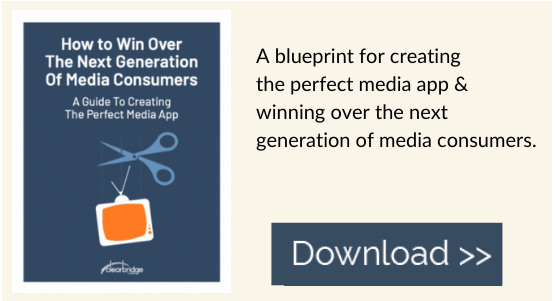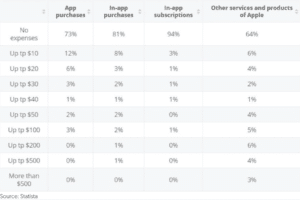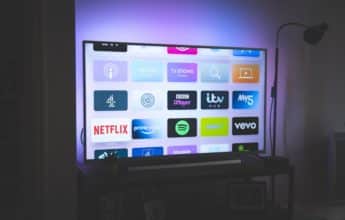The OTT streaming ecosystem is growing rapidly, and the pandemic has only accelerated consumer adoption to OTT. In 2020 alone, cable TV lost over 1.4 million subscribers.
For many broadcasters and content providers looking to cash in on this trend, the main question about getting their users to adopt a new platform to consume their content revolves around monetization. How can you make money on OTT? What are the various models available to content creators to monetize their content? OTT providers have a few key models to choose from. In this piece, we’ll break them all down, what they mean, and the pros and cons of each.
Common App Monetization Strategies
There are two major app monetization strategies currently used: advertising-based (AVOD) and subscription-based (SVOD). For the former, almost all advertisements are in video form – the same format they’ve been for decades, just on a different medium. The latter, is a monetization strategy in itself, with the direct pay model circumventing the need for advertising.
AVOD
For media companies using advertising models, the opportunities to generate revenue are vast. It’s a relatively simple model. Audiences can access videos without paying money to the content owner, or to the platform owner in exchange for subjecting themselves to the advertisement(s) that run in front of, or alongside, or in the middle of, or at the end of the video. These platforms are all digitally delivered over the internet giving advertisers new more target advertising options. The most famous of all AVOD platforms is YouTube, but there are many more.
While video ads are still the most common format, there is ample opportunity to offer ads that are more engaging and optimized for the device the viewer is using. Examples include:
- Interactive rich media ads including slideshows, quizzes, games, and more
- In-app purchases integrated with content (Download or Buy Now prompts that don’t interrupt the user experience)
- Sponsored features, social or otherwise
OTT platforms offer the ability for highly-targeted, dynamic advertising capabilities that work for both streamed and nonlinear content viewing. For the content providers themselves, there is the option of considering OTT, advertising-based, or mixed model monetization. The opportunities to expand revenues are there; implementing in a way that doesn’t hurt the user experience is the real challenge.
SVOD
Subscription based monetization models are based on paying the content provider directly, which typically circumvents the need for ads. Services like HBOGo and Netflix are two prominent examples of providers that work on an ad-free, subscription-based monetization model. SVOD operators offer a mix of content to an audience in exchange for a fee, paid monthly, weekly, or annually. Hallmarks of an SVOD service are: exclusive content, subscription fees, no advertising, with content delivered to audiences over the internet. Platforms typically look to license content on an exclusive basis, to draw audiences in based on the shows they have available. Typically these shows are paid a license fee in exchange for the rights. Some of these fees have bonuses, or are structured with variable payout systems where content providers are rewarded fees based on the number of views their programs receive. SVOD platforms need deep libraries of content to keep their audiences interested, and exclusive access to premiere premium content to prove the ongoing value of the subscription.
Redefining App Monetization Strategies
However, there is an opportunity to do much, much more. In addition to the above mentioned monetization strategies, platforms can break open new sources of revenue by adding basic nteractivity. Even the most basic video ads can be ramped up to take advantage of the technological capabilities that the medium offers. The TV Everywhere applications we made for a major media client, for example, added basic interactivity to traditional video ads on the app. With a single click, users could invoke the web browser and navigate to the websites of the advertisers. And this is just scratching the surface – the capabilities to completely transform advertising models are there, we just need to get imaginative.
While it’s difficult to envision ads that go beyond traditional video spots – especially for apps that serve video content – the fact of the matter remains that on mobile apps you have an audience of users, not just viewers. They have the ability to interact, rather than just watch.
With Smart TVs and media streaming players, you can serve ads that are much more interactive. Nexus, for example, has a controller that can be purchased, and Roku’s remote can be used for playing games. Also, platforms like Apple TV support slideshows and other rich media that open up advertising possibilities.
Some companies have opted to offer games in place of traditional spots. But ads can also take the form of slideshows, quizzes, and other experiences where the ad is not just a push message, but an immersive interactive experience. Users can control what is happening on the screen and how they interact with content with their mobile devices or controllers. These ads can also be directly related to the content being consumed, which allows advertisers to reach an audience targeted based on viewing behavior and activity within the app.
For media companies looking to attract advertisers, these could be offered as sponsored features, like the clip sharing function we implemented for one of our media clients’ TV Everywhere app, though there are other opportunities as well.
In-App Purchases Integrated With Content
Though not an entirely new concept, we think in-app purchases that are integrated into content are still in their infancy. The major challenge to this isn’t necessarily technological but has to do with user experience. Do users even want this option? Is there a way to include it without negatively affecting the user experience? We believe the answer is yes.
For those leveraging the SVOD monetization model, in-app purchases can be a valuable revenue stream. Infact, the big streaming device players have enabled in-app purchases, with the likes of Amazon Fire TV, Apple TV, Android TV and Roku. However, to enjoy sustainable monetary benefits, providers must focus on quality, ease of use and a stand out value proposition.
While some may be weary of viewers willingness to pay for app purchases, in-app purchases or in-app subscriptions, this chart from Apple via Statista gives a nice indication of user behavior based on the level of expenses:
Final Takeaways
As discussed above, we typically see two distinct app monetization strategies in the media space: subscription-based and advertising-based. But the two don’t have to be mutually exclusive. A hybrid model is not only possible but feasible. In fact, the concept has been proven (albeit for a music app) with Spotify, which offers both a free and premium service. The free service contains ads, while the premium service is ad-free.
This is a viable app monetization strategy for media applications, and with the number of freemium products available on the market, it’s surprising this isn’t more common. It’s also a simple model: users who don’t want to see ads pay for the service, while those who don’t want to pay are served advertisements. This allows for companies to offer content directly to users via OTT, and additionally to collect advertising revenue.
Most OTT streaming apps tend to follow predictable advertising formats and monetization models. However, advancements in technology coupled with shifting viewing patterns present new opportunities. Rethinking app monetization strategies – from advertising methods to the business model itself – will help media companies building applications to have a more robust, revenue-driven solution, without interrupting the user experience.






